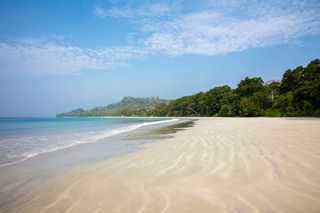Deadly hospital superbug found on a remote island beach
The findings mark the first time researchers have seen this multidrug-resistant organism in the "wild."

A deadly hospital superbug has been discovered on a remote island beach, marking the first time researchers have seen this multidrug-resistant organism in the "wild."
The findings, published Tuesday (March 16) in the journal mBio, may provide clues to the origins of this superbug, Candida auris, which mysteriously popped up in hospitals around the world about a decade ago.
"It's a medical mystery, where did it come from," said Dr. Arturo Casadevall, chair of the Department of Molecular Microbiology and Immunology at Johns Hopkins Bloomberg School of Public Health in Baltimore, who wrote an editorial accompanying the study. The new findings are "a very important part of the puzzle," Casadevall told Live Science.
Related: Beachgoers beware? 5 pathogens that lurk in sand
C. auris is a fungus that was first discovered in 2009 in a patient in Japan. It seemed to quickly spread around the world, appearing on three different continents around the same time. The microbe can cause serious bloodstream infections, particularly in patients who require catheters, feeding tubes or breathing tubes, according to the Centers for Disease Control and Prevention (CDC). The infections can be difficult to treat because the microbe is often resistant to multiple antifungal drugs; and it can also linger on environmental surfaces. "When it gets into a hospital, it's a nightmare" for infection control, Casadevall said. In 2019, the CDC declared C. auris an "urgent threat" to public health.
Although related species have been detected in plants and aquatic environments, C. auris hasn't been found in natural environments. Casadevall and colleagues have previously hypothesized that increased temperatures due to climate change may have caused C. auris to adapt to higher temperatures in the wild, and thus allowed the fungus to make the jump to humans, whose normal body temperature is typically too hot for most fungi to survive.
Inspired by this hypothesis, study lead author Dr. Anuradha Chowdhary, a medical mycologist at the University of Delhi, India, and colleagues analyzed samples of soil and water collected from eight sites around the Andaman Islands, a remote, tropical archipelago between India and Myanmar.
Sign up for the Live Science daily newsletter now
Get the world’s most fascinating discoveries delivered straight to your inbox.
The researchers isolated C. auris from two sites: a salt marsh wetland where virtually no people ever go, and a beach with more human activity.
The C. auris isolates from the beach were all multidrug resistant and were more closely related to strains seen in hospitals compared with the isolates found in the marsh, Chowdhary said in a statement.
One isolate found in the marsh was not drug-resistant and grew more slowly at high temperatures compared with the other isolates. This finding suggests that this isolate could be a "wilder" strain of C. auris, one that hadn't yet adapted to the high body temperatures of humans and other mammals, Casadevall said.
The study provides some support for the global warming hypothesis because, first and foremost, it identified C. auris in a natural environment, which is a requirement for the hypothesis, the editorial said. In addition, the "wilder" isolate could be a missing link of sorts between wild C. auris and those that cause infections in hospitals.
Still, the study does not prove that C. auris naturally lives on the Andaman Islands, or that it originated there. It's possible that the microbe could have been introduced by people, particularly at the beach site that had more human activity. In addition, some researchers have wondered whether the microbe may have been carried by ocean currents from areas where human waste was dumped into the water to the shores of the Andaman Islands, Casadevall said.
The new findings will likely spur more researchers to look for C. auris in natural environments, and to compare wild strains with those from hospitals, Casadevall said. Studies could also examine whether wild C. auris isolates with less heat tolerance could "evolve" in a lab setting to grow at higher temperatures, thus providing more support for the global warming hypothesis, the editorial said.
If it is indeed shown that C. auris came from the wild, and that global warming was a factor in its jump to humans, researchers are concerned that more pathogens could make the same leap. Many fungal organisms are harmful to insects and amphibians, but not to people because of our high body temperatures, Casadevall noted.
"If this idea gets validated … we need to start mapping out more of these pathogens that are out there so we don't get surprised," like we got surprised by the new coronavirus, Casadevall said.
Originally published on Live Science.

Rachael is a Live Science contributor, and was a former channel editor and senior writer for Live Science between 2010 and 2022. She has a master's degree in journalism from New York University's Science, Health and Environmental Reporting Program. She also holds a B.S. in molecular biology and an M.S. in biology from the University of California, San Diego. Her work has appeared in Scienceline, The Washington Post and Scientific American.
Most Popular


